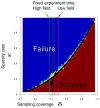Beyond Fourier
- PMID: 28385517
- PMCID: PMC5730986
- DOI: 10.1016/j.jmr.2017.03.017
Beyond Fourier
Abstract
Non-Fourier methods of spectrum analysis are gaining traction in NMR spectroscopy, driven by their utility for processing nonuniformly sampled data. These methods afford new opportunities for optimizing experiment time, resolution, and sensitivity of multidimensional NMR experiments, but they also pose significant challenges not encountered with the discrete Fourier transform. A brief history of non-Fourier methods in NMR serves to place different approaches in context. Non-Fourier methods reflect broader trends in the growing importance of computation in NMR, and offer insights for future software development.
Keywords: Non-Fourier; Nonuniform sampling; Spectrum analysis.
Copyright © 2017 Elsevier Inc. All rights reserved.
Figures




References
-
- The Human Dark Proteome Initiative. 2015 http://darkproteome.org/
-
- Kaptein R, Dijkstra K, Nicolay K. Laser photo-CIDNP as a surface probe for proteins in solution. Nature. 1978;274:293–294. - PubMed
-
- Mueller RM, Buchal C, Folle HR, Kubota M, Powell F. A Double-stage Nuclear Demagnetization Refrigerator. Cryogenics. 1980;20:395–407.
-
- Kenyon B, Kleinberg R, Straley C, Gubelin G, Morriss C. Nuclear Magnetic Resonance Imaging — Technology for the 21st Century. Oilfield Review. 1995;7:19–33.
Publication types
MeSH terms
Grants and funding
LinkOut - more resources
Full Text Sources
Other Literature Sources

